Making Leaps for the Northern Leopard Frog
October 30, 2024
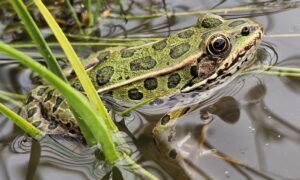
Released northern leopard frog that was head-started at the ABC from tadpoles brought in from Creston BC. Taken at the reintroduction site near Kimberley BC.
2024
Between May and August, with the support of our partners from the British Columbia Northern Leopard Frog Recovery Team, we released 6,127 tadpoles and 18 frogs at the Cherry Meadows/Sparrowhawk Farm reintroduction site near Kimberley, British Columbia.
This marks the third year of releases at this specific site, carefully chosen based on habitat suitability for breeding, foraging, and overwintering. The area includes the Nature Conservancy of Canada’s Cherry Meadows Conservation Area and the Sparrowhawk Farm wetland complex, which offer ideal conditions for the frogs’ survival, including a creek with suitable temperature and dissolved oxygen levels for overwintering.
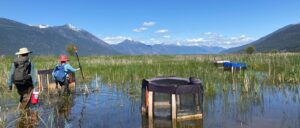
Investigating breeding success between wild male and female northern leopard frogs raised under human care in Creston B.C.
We are proud to partner with other conservation organizations, government agencies, and zoos, including the Edmonton Valley Zoo and Vancouver Aquarium, to breed, translocate, and release northern leopard frogs in British Columbia, where only one known natural wild population remains.
Historically widespread, this species has seen a dramatic decline due to habitat loss, invasive species, and disease. The Rocky Mountain population in British Columbia is listed as Endangered federally and Critically Imperiled provincially.
With your generosity, we will continue vital efforts in conservation translocations, reintroducing these frogs to their historical ranges and giving them a chance to thrive once again. Your support helps prevent the local extinction of this remarkable species!
Translocations Three Ways
Our collaborative recovery program employs various methods to maximize the number of tadpoles released into the wild, supporting the species throughout every stage of their life cycle. Thanks to you, we also conduct research to identify the most effective tools and techniques to aid in their recovery.
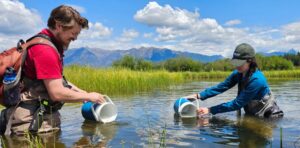
Staff from the Vancouver Aquarium and the Wilder Institute releasing tadpoles conservation-bred at Vancouver Aquarium at the reintroduction site near Kimberley BC.
Wild to Wild: Tadpoles from Creston, British Columbia, where the last known natural wild population exists, were moved to the reintroduction site. Four release wetlands were selected from the larger complex based on water depth, vegetation cover, and dissolved oxygen levels, among other suitability factors. Before release, the tadpoles are slowly acclimated to the water chemistry and temperature of their new environment to help with the transition. This year, 3,062 tadpoles were translocated using this method!
Additionally, this year our team investigated breeding success between wild male and female northern leopard frogs raised under human care. This research produced one egg mass, resulting in the release of 117 tadpoles at the reintroduction site and an additional 50 tadpoles that remained in Creston.
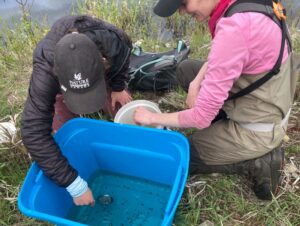
Northern leopard frog release (wild to wild, May 22, 2024).
Head-starting: Approximately 400 tadpoles were brought under human care at our Archibald Biodiversity Centre (ABC) and at the Edmonton Valley Zoo to be nurtured through a vulnerable period of their lives. There, for three to six weeks, they were kept safe from predators and were provided with the expert care necessary to grow into healthy individuals. Some tadpoles were held back to mature into frogs before release, while others became part of conservation breeding programs to produce tadpoles for future releases.
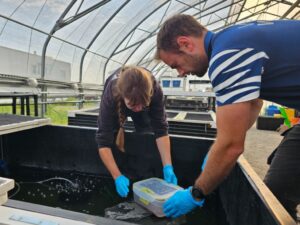
Animal Care team preparing northern leopard frogs that were head-started from tadpoles brought in from Creston BC for transport and release at the reintroduction site near Kimberley BC. 2024.
Conservation Breeding: Conservation breeding involves managing a population under human care to produce genetically diverse individuals for release. The Wilder Institute, Vancouver Aquarium, and Edmonton Valley Zoo have run such programs for the northern leopard frog since 2018, 2009, and 2019, respectively. This year, 2,549 tadpoles were bred at the Edmonton Valley Zoo and Vancouver Aquarium and released into the wild.
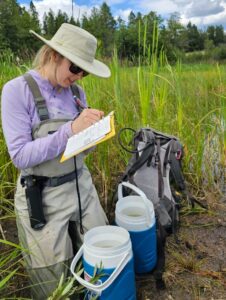
Preparing tadpoles conservation-bred at the Vancouver Aquarium for release at the reintroduction site near Kimberley BC.
Breeding amphibians under human care is often challenging! Northern leopard frog conservation breeding programs often see lower reproductive success than wild populations, which is problematic for reintroduction efforts. To address this, we hosted a workshop led by Dr. Allison Julien of the Fort Worth Zoo and Dr. Doug Whiteside from our team at the Wilder Institute, focusing on enhancing tadpole production through techniques like in-vitro fertilization.
Looking Ahead
Our researchers are monitoring the released frogs to see how they are adapting to their new home. As the tadpoles metamorphose into frogs, researchers will track their progress by weighing, measuring, and photographing each frog to estimate how many are successfully transitioning to the next life stage. We haven’t yet had a chance to dive too deep into the data from this year to determine how many unique individuals we are seeing, but we have observed up to 150 frogs in one week during surveys so far. We expect that number to grow as we continue to survey into the fall!
Despite positive signs, such as a higher survival rate from tadpole to recently metamorphosed frogs and increased frog size compared to previous release sites, challenges remain. One major concern is the presence of chytrid, a fungal disease that can affect the overwinter survival of young frogs. This fall, we plan to treat some frogs for the disease and compare their survival rates to untreated ones to assess the impact.
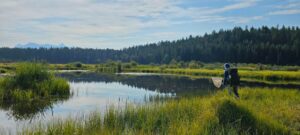
Surveying for young of year northern leopard frogs (frogs recently metamorphosed from tadpoles released earlier in the season) at the reintroduction site near Kimberley BC.
The journey to recover the northern leopard frog is challenging, but with your support, we remain hopeful! By strengthening conservation breeding efforts and continuing reintroduction programs, your generosity is working to safeguard this vital species. Northern leopard frogs play an important role in their ecosystems; with your dedication, we are committed to restoring their presence in wetlands across British Columbia.
Together, we can bring their calls back to the wild and make a lasting impact on their future.
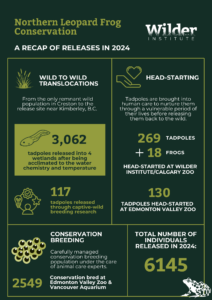
Infographic summarizing Northern Leopard Frog conservation programs.
